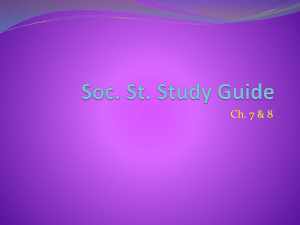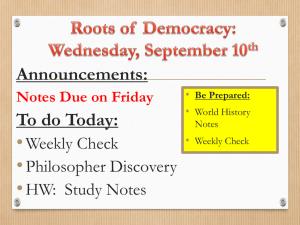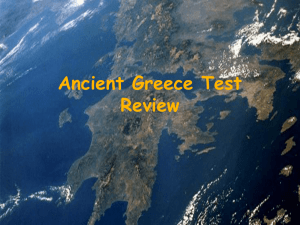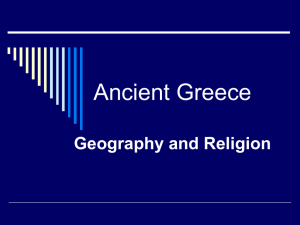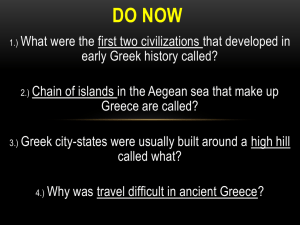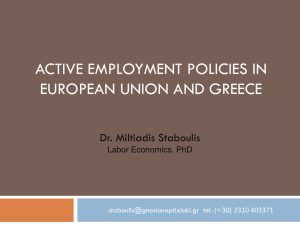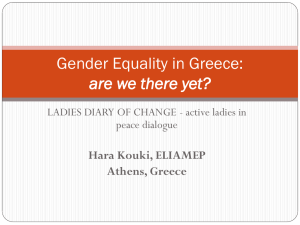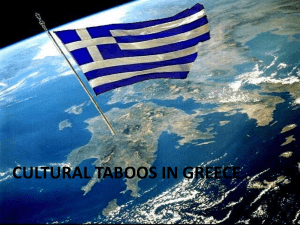Director, Institute for IT Innovation
advertisement
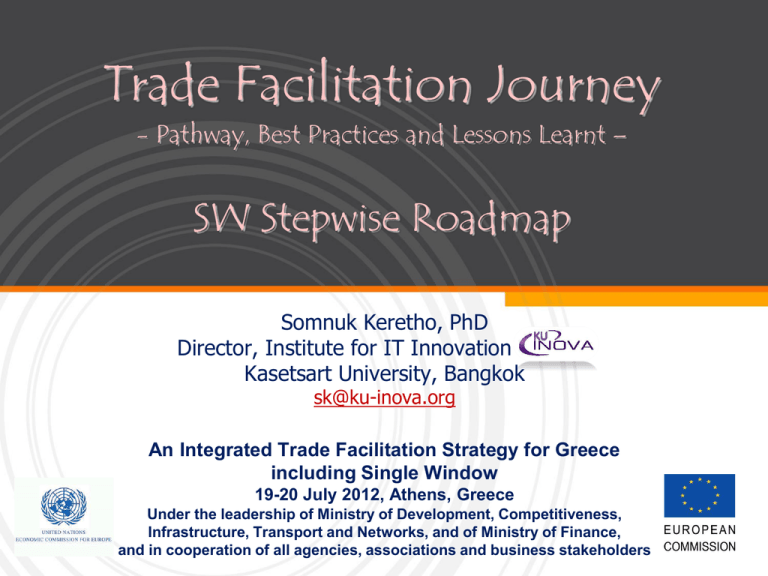
Trade Facilitation Journey - Pathway, Best Practices and Lessons Learnt – SW Stepwise Roadmap Somnuk Keretho, PhD Director, Institute for IT Innovation Kasetsart University, Bangkok . sk@ku-inova.org An Integrated Trade Facilitation Strategy for Greece including Single Window 19-20 July 2012, Athens, Greece Under the leadership of Ministry of Development, Competitiveness, Infrastructure, Transport and Networks, and of Ministry of Finance, and in cooperation of all agencies, associations and business stakeholders A Chinese Proverb “If you don’t know where you are going, any road will do.” A Watts Humphrey’s Proverb “But if you don’t know where you are, a map won’t help.” 1. Deciding about the goal (where we want to go), 2. then having a guiding map will be quite useful, 3. but only if we can assess where we are now referencing to the map. The Objectives of this presentation Opportunities in enhancing national trade competitiveness by improving import/export/trade/transit procedures and documentation handlings Potential benefits of SW in enabling the above vision Why a systematic framework and guiding map for SW planning and implementation is needed. An Integrated Trade Facilitation Strategy for Greece including Single Window, 19-20 July 2012, Athens, Greece Page 3 The Objectives of this presentation To discuss the SW Roadmap* based on its evolutionary development nature (different development levels/scopes of Single Window) To suggest that this SW Roadmap shall be used as a recommended Long-Term Development Roadmap for Greek engaging in establishing the SW environment, and To be used also as a Reference Model for 1. assessing the current or “as-is” condition of the country, and then for 2. prioritizing for the next target or “to-be” SW environment (where the country wants to go/to achieve). * This roadmap is formulated from actual experiences of many countries around the world especially from The 2005 Executive Forum “Paperless Trade in International Supply Chains: Enhancing Efficiency and Security,” and as reported in “A Roadmap towards Paperless Trade (UN ECE/TRADE/371, 2005)” and in “Paperless Trade in International Supply Chains - Enhancing Efficiency and Security (UN ECE/TRADE/351, 2008)”. An Integrated Trade Facilitation Strategy for Greece including Single Window, 19-20 July 2012, Athens, Greece Page 4 Trade Movement – 3 Kinds of Flow Seller (Exporter) Buyer (Importer) Physical Goods Our Improvement Opportunities Payment Information/Documents Traders Cargo Insurance Banks Traders Exporters Importers Freight Forwarders Customs Officers Ministry of Health Ministry of Agriculture Ship Agents Transport-Operators Economic Operators Chamber of Commerce Terminal-Operators Carriers An Integrated Trade Facilitation Strategy for Greece including Single Window, 19-20 July 2012, Athens, Greece Page 5 The issue is about Increasing National Trade Competitiveness by improving Import/Export/Transit/Trade Procedures and Documents Handlings among Government Agencies, Business Entities and Logistics Service Providers (this is called “Trade Facilitation” improvement) UNNExT Workshop on SW Planning and Implementation, 14-15 December 2011, Geneva Page 6 Thai Case Example Documents related to Exportation of Rice (from purchase order until the cargo container leaving the sea port) 36 Documents involving 15 parties, and more than 1,140 data elements to be filled in 1. Proforma Invoice (35) 2. Purchase Order (39) 3. 21. Master Sea Cargo Manifest(17) 22. House Sea Cargo Manifest (37) Commercial Invoice (51) 23. Export Declaration (114) 4. Application for Letter of Credit (24) 24. Good Transition Control List (27) 5. Letter of Credit (32) 25. Application for Permission to Export Rice (KP. 2) (24) 6. Packing List (25) 26. Sales Report (KP 3) (21) 7. Cargo Insurance Application Form (20) 27. 8. Cover Note (23) Application for the Collection of the Permit for the Export of Rice (A. 3) (35) 9. Insurance Policy (24) 28. Permit for the Export of Rice (A. 4) (35) 10. Booking Request Form – Border Crossing (25) 29. 11. Booking Confirmation – Border Crossing (30) Application for Certificate of Standards of Product (MS. 13/1) (44) 12. Booking Request Form – Inland Transport (16) 30. Certificate of Analysis (17) 13. Booking Confirmation – Inland Transport (18) 31. Certificate of Product Standards (MS. 24/1) (45) 14. Bill of Lading (42) 32. Certificate of Fumigation (21) 15. Empty Container Movement Request (TKT 305) (20) 33. Application for Phytosanitary Certificate (PQ. 9) (29) 16. Request for Port Entry (TKT 308.2) (27) 34. Phytosanitary Certificate (33) 17. Equipment Interchange Report (EIR) (24) 35. Application for Certificate of Origin (42) 18. Container Loading List (28) 36. Certificate of Origin (38) 19. Container List Message (32) 20. Outward Container List (34) Buy/Pay Docs Transport Docs Regulatory Docs * Number in parenthesis is the no. of data elements An Integrated Trade Facilitation Strategy for Greece including Single Window, 19-20 July 2012, Athens, Greece Page 7 A Business Process Analysis - in Exporting Jasmine Rice from Thailand - 16 days are required for these procedures and documents transaction Day 20 Time-Procedure Chart 4 days 16 15 3 days 10 2 days 5 2 days 2 days 0 2 3 days 4 6 7 1 day 8 9 10 1 day 11 1 day 13 14 12 5 3 1 1 2 3 4 5 6 1. Buy - Conclude sales contract and trade terms 2. Obtain export permit 3. Arrange transport 4. Arrange the inspection and fumigation 5. Obtain cargo insurance 6. Provide customs declaration 7. Collect empty container(s) from yard 7 8 9 10 11 12 13 14 Process 8. Stuff container(s) 9. Transfer to port of departure 10. Clear goods through customs 11. Handle container at terminal and stow on vessel 12. Prepare documents required by importer 13. Verify the accuracy/authenticity of exported cargo 14. Pay - Claim payment of goods An Integrated Trade Facilitation Strategy for Greece including Single Window, 19-20 July 2012, Athens, Greece Page 8 Exporting Rice (from purchasing time till the vessel leaving the port) 36 required documents (only 4-6 e-documents) 15 Stakeholders involved 14 big steps (123 small steps) 16 days needed (all together) – 6 days for regulatory procedures – 7 days for transport-related procedures – 12 days for traders, banks and insurance procedures An Integrated Trade Facilitation Strategy for Greece including Single Window, 19-20 July 2012, Athens, Greece Page 9 Indicators can help decision makers to understand the importance of import/export procedures related to national trade competitiveness World Bank’s Trading Across Borders Report (comparing 183 countries) Indicators Greece Documents to export (number) 5 Time to export (days) 20 Cost to export (US$ per container) 1,153 Thailand 5 14 625 France Sweden Singapore 2 9 1,078 3 8 697 4 5 456 Reference - World Bank’s Doing Business – Trading Across Border (18 July 2012) www.doingbusiness.org Comparing among 183 countries, the costs and procedures involved in exporting (and importing) a standardized shipment of goods are studied. Every official procedure involved is recorded – starting from the final contractual agreement between the two parties, and ending with the delivery of the goods. An Integrated Trade Facilitation Strategy for Greece including Single Window, 19-20 July 2012, Athens, Greece Page 10 Time & Documents needed for export a standardized cargo* 5 documents needed 5 documents needed * More documents will be needed for agriculture or dangerous goods. Reference - World Bank’s Doing Business – Trading Across Border (18 July 2012) www.doingbusiness.org An Integrated Trade Facilitation Strategy for Greece including Single Window, 19-20 July 2012, Athens, Greece Page 11 Some countries are easier & faster to trade, but some countries are more difficult to trade with. Complications in terms of required documents and procedures, and time for exporting a standardized container of goods (regional averages) As an example, the average time to export from OECD high-income countries is about 2 times faster than Greece. An Integrated Trade Facilitation Strategy for Greece including Single Window, 19-20 July 2012, Athens, Greece Page 12 Why trading across borders in some countries are more difficult, time consuming and expensive? Procedures and documents handling remain largely paper dependent Missing and incorrect documentation slows progress through the supply chain Keeping documents & freight in sync is complex and costly Multiple parties capturing the same data is inefficient and error prone An Integrated Trade Facilitation Strategy for Greece including Single Window, 19-20 July 2012, Athens, Greece Page 13 Why trading across borders in some countries are easier, faster and less risky? Mainly because those countries gradually simlify/transform/reform their paper-based environment into Collaborative e-Government/e-Business platform. Paper-based Environment Paperless or e-Document Environment An Integrated Trade Facilitation Strategy for Greece including Single Window, 19-20 July 2012, Athens, Greece Page 14 Economic Impacts because of the delay on trading across borders Each additional day of delay (e.g. because of trade logistics procedures) reduces trade by at least 1% Ref: “Trading on Time,” Simeon Djankov, Caroline Freund, and Cong S. Pham, World Bank (2007). “Direct and Indirect Cost from import/export-related procedures and required documents is about 1-15% of product cost.” Ref: “Quantitative Assessment of the Benefits of Trade Facilitation,” OECD (2003). An Integrated Trade Facilitation Strategy for Greece including Single Window, 19-20 July 2012, Athens, Greece Page 15 Measurement of Impacts (on time, cost, and complexity reduction) A Thai Case because of NSW in Thailand (2009) - through reform, and applying IT in Paperless Customs and NSW Transaction Cost reduction from 848 to 625 (~220 USD) per container (x 3.5 million TEU per year) = 770 Million USD transaction cost reduction per year By World Bank www.doingbusiness.org Feb 2009 An Integrated Trade Facilitation Strategy for Greece including Single Window, 19-20 July 2012, Athens, Greece Page 16 The Vision & Goals Vision: Increasing national trade competitiveness by improving import/export procedures and documentation transactions/handlings Quantitative Goals: – 25% better, faster, and cheaper in trading across borders* within 5 years** ** The quantitative numbers here are given just an example, which happens to be the vision among 21 APEC many economies for 2011-2015. (APEC = Asia and Pacific Economic Cooperation) * Referring to World Bank’s Index (www.doingbusiness.org) “better” means better control, e.g. less fraud, less confusion, less number of steps, and better risk management. “faster” means less numbers of days/hours for procedures and document handling, and “cheaper” means less cost (both direct and indirect cost). An Integrated Trade Facilitation Strategy for Greece including Single Window, 19-20 July 2012, Athens, Greece Page 17 Why a holistic and systematic framework is needed? (for implementing/transforming this Vision into Reality) Because there are so many challenges to be tackled to transform this Vision into Reality. Vision e.g. of APEC member economies 25% better, faster, cheaper trading across border* within 5 years (2011-2015) Many Document Requirements Complicated Laws and Regulations Trade Procedures Connectivity within Many Stakeholders Conflict of Interest the country Compliance Standards Many different ICT systems Governance Difficulty in trade data exchange Regional Connectivity People and Business In-Readiness Lack of Understanding Change Management Reality achieving trade transaction cost and time Reduction, better compliance goals Inadequacy in Technology Infrastructure System Development Barriers in Interoperability * Referring to World Bank’s Index (www.doingbusiness.org) An Integrated Trade Facilitation Strategy for Greece including Single Window, 19-20 July 2012, Athens, Greece Page 18 What is SW Implementation Framework (SWIF)? SWIF is a systematic architecture-based framework for guiding the Single Window Planning and Implementation into reality. SWIF adapts the concept of enterprise architecture and development methodology* to describe steps how to systematically derive the single window strategic architecture and the master plan for SW implementation. SWIF Authors: Markus Pikart (UNECE), Thayanan Phuaphanthong and Somnuk Keretho (Kasetsart University, Thailand), Wout Hofman (TNO), and Eveline van Stijn and Yao-Hua Tan (Vrije Universiteit Amsterdam) “ Adopted from An Enterprise Architecture Framework, called TOGAF-9. An Integrated Trade Facilitation Strategy for Greece including Single Window, 19-20 July 2012, Athens, Greece Page 19 Key Concepts and Guidelines within SWIF 1. Visions & Goals Alignment – formulating SW visions and goals, where possible with quantitative indicators, by aligning also with national and/or regional policy directions. 2. SW Stepwise Roadmap – as a reference model and long-term development roadmap 3. Critical Success Components - systematically decomposing and structuring SW implementation challenges into smaller and easier manageable components (10 components are proposed). • SW Vision Articulation and Political Will Creation • Stakeholder Collaborative Platform Establishment • Business Process Analysis and Simplification • Data Harmonization and Document Simplification • ..……. 4. SW Management Process for analysis, planning and overseeing the SW projects by walking through those 10 components iteratively. An Integrated Trade Facilitation Strategy for Greece including Single Window, 19-20 July 2012, Athens, Greece Page 20 Single Window Roadmap Potential benefits in Five Evolutionary Development Levels 5. Integrating the National Logistics Platform into a Regional Info-Exchange System 4. Integrated National (Cross-border SW) Logistics 3. Port Community Platform System (PCS) (interconnecting with entire port community) 2. Integration with other Regulatory 1.Paperless Bodies Customs Declaration System (Integrated SW) (Port SW) (Regulatory SW) (Paperless Customs) Note that in many countries, Maturity Level 3 (PCS) was fully developed before Maturity Level 2 (integration with other regulatory bodies). An Integrated Trade Facilitation Strategy for Greece including Single Window, 19-20 July 2012, Athens, Greece time Page 21 Single Window Roadmap in Five Evolutionary Development Levels and their Key Capabilities Level 1: Paperless Customs Declaration System (Paperless Customs) Submission of paperless Customs declaration, e-payment with banks for Customs duty, e-Container loading list (to associate between Customs declaration and physical containers of those declared goods), and risk-based inspections. Level 2: Integration with other Regulatory Bodies (Regulatory SW) Extending the paperless Customs system by interconnecting with other governments’ IT systems for exchanging import/export e-permits and e-certificates with Customs Department for more accurate and faster Customs clearance, single window data entry for electronic submissions of application forms, and status e-tracking. Level 3: Port Community Systems (PCS) in major sea/air ports (Port SW) Interconnection and e-document exchange for efficient port operations among all related stakeholders, e.g. customs brokers, freight forwarders, transporters, terminal operators, Customs department, warehouses, port authority, and other control agencies. Level 4: An Integrated National Logistics Platform (Integrated SW) Extension the interconnection with importers/exporters, logistics-service providers, insurance companies, banks for online payment of services and goods, Level 5: A Regional Information-Exchange System (Cross-border SW) Cross-border e-document exchange between two or more economies. EDI = Electronic Data Interchange Note that in some cases, PCSs in major ports (as in Level 3) within a country were being fully developed before Level 2. And some countries start exchanging e-document across the countries (as in Level 5) even though they haven’t fully completed Level 3 or 4. An Integrated Trade Facilitation Strategy for Greece including Single Window, 19-20 July 2012, Athens, Greece Page 22 Single Window Roadmap in Five Evolutionary Development Stages Level 1: Paperless Customs + e-Payment for Customs Duty + e-Container Loading List + and electronic risk-based inspection Level 2: Connecting Other Government Back-end IT systems, and e-Permit Exchange with Paperless Customs System Level 3: e-Documents Exchange among Stakeholders within the (air, sea) port community Level 4: An integrated national logistics platform with also traders and logistics-service providers information exchange National e-logistics Platform Traders Port-Community Information Exchange Banks for various kinds of e-payment Level 5: A regional Other Regulatory Bodies for information-exchange E-Permits/e-Certificates Exchange system Paperless Customs Internet Insurance Companies NSW Airlines Importer/Exporter/ Customs Broker/ Representative/ other Stakeholders Duty Free Zones Note that in many countries, Level 3 was being developed before Level . A regional informationexchange system or cross-border paperless trade Freight Forwarders and Logistics Service Providers Air Port Authority Port Authority etc. Terminal Operators Ship Agents An Integrated Trade Facilitation Strategy for Greece including Single Window, 19-20 July 2012, Athens, Greece Page 23 Single Window Roadmap Five Evolutionary Development Levels - Few Case Examples & Variations Level 1: Paperless Customs Declaration System (Paperless Customs) Belize, Chile, Estonia, Pakistan, Turkey: Electronic Data Interchange for Customs Declaration Morocco, Nigeria, Palau, Suriname, Vietnam: Using Risk-based Inspections Thailand: Paperless Customs with Risk-based Inspection, and online Customs Duty Payment Level 2: Integration with other Regulatory Bodies (Regulatory SW) Singapore: TradeNet where traders submit electronic data in a single window to obtain all necessary import/export-related permit/certificate and customs declarations. Level 3: Port Community Systems (PCS) in major sea/air ports (Port SW) Germany: DAKOSY, a port community system used at the Hamburg sea port Level 4: An Integrated National Logistics Platform (Integrated SW) Hong Kong, SAR: DTTN (Digital Trade and Transportation Network), integrating EDI/Paperless Customs with the Regulatory SW and Trader Community. Republic of Korea: u-Trade Hub Level 5: A Regional Information-Exchange System (Cross-border SW) e-SPS (Sanitary and Phyto-sanitary) documents exchange between Australia (AQIS) and New Zealand (NZFSA) to facilitate cross-border trading on Agri-food products e-CO (Certificate of Origin) information exchange between Korea and UK ASEAN Single Window: Cross-border data exchange among 10 ASEAN members (in progress) An Integrated Trade Facilitation Strategy for Greece including Single Window, 19-20 July 2012, Athens, Greece Page 24 Recommendations Countries may use the SW Roadmap SW reference model for the development of the national SW to 1. assessing the current or “as-is” level of the national SW, and for 2. prioritizing for the next target or “to-be” SW development For example, by comparing the “as-is” condition of the country with the SW reference model (from Level 1 up to Level 5), and finding out that If the country doesn’t have any Customs EDI system or risk-based inspections in place yet, then the first priority for development is the Paperless Customs with risk-based inspections (Level 1). If the country’s already established a full paperless Customs but not interconnecting with any other regulatory agencies and there are a lot of cumbersome procedures related to import/export permits/certificates, then the regulatory SW could be the next target to be developed (Level 2). If the country’s already established a full paperless Customs and/or a regulatory SW, but there are a lot of stakeholders and transaction complications at the major ports, then there are opportunities to interconnect e-documents among stakeholders in those major sea port(s) and air port(s) – establishing Port Community Systems (Level 3). An Integrated Trade Facilitation Strategy for Greece including Single Window, 19-20 July 2012, Athens, Greece Page 25 Recommendations (cont) For example, by comparing the “as-is” condition of the country with the SW reference model (from Level 1 up to Level 5), and finding out that If the country’s already established a regulatory SW and Port Community Systems within major ports, and there are a lot of small and medium importers/exporters and logistics providers still lacking of good supporting tools for document transactions and procedures, then there may be some opportunities to interconnect e-documents among business traders, logistics service providers, the regulatory SW and/or perhaps the Port Community Systems – establishing Integrated National Logistics Platform (Level 4). If the country’s already established the Paperless Customs, and/or the regulatory SW, and/or Port Community Systems within major ports, and any bi-lateral or sub-regional trade agreement is established, then there are some good opportunities to develop a cross-border information exchange between and among the regional members – establishing a Regional InformationExchange System (Level 5). An Integrated Trade Facilitation Strategy for Greece including Single Window, 19-20 July 2012, Athens, Greece Page 26 Summary Improving import/export procedures and documentation is realized by many countries as a strategy for enhancing national trade competitiveness It is important to establish and mandate these vision and quantitative goals as a strategic development agenda for the nation. From the experience of many countries, these vision and goals could be realized by gradually and systematically transforming related paperbased environment into more efficient paperless/electronic-document environment. IT-enabled SW environment along with its associated reform has the potential to enable the above vision. Many complicated challenges of implementing the vision of SW into reality is a reason why a holistic and systematic framework and guidelines for SW planning and implementation are needed. Some key concepts and guidelines within this framework are introduced. An Integrated Trade Facilitation Strategy for Greece including Single Window, 19-20 July 2012, Athens, Greece Page 27 Summary The scopes (and definitions) of, so called, Single Window (IT-enabled trade facilitation environments) are quite diverse in reality. The evolutionary SW Roadmap should assist the policy managers and policy makers to understand the overall and long-term roadmap of SW development and its potential benefits in each maturity level (stage). This SW Roadmap could be used as a reference model for at least 2 purposes For assessing the “as-is” conditions of a country by comparing to this reference model (to understand where we are in the map). For prioritizing the next “to-be” stage where we want to go. An Integrated Trade Facilitation Strategy for Greece including Single Window, 19-20 July 2012, Athens, Greece Page 28 Recommendations for Greece Conduct a detailed Business Process Analysis to identify bottlenecks and propose improvement recommendations, with e.g. 1. Simplification of Customs Declaration and Clearance 2. Elimination of Unnecessary Documents in the pre-Customs procedures, e.g. some certain certificates Quick Win 3. Automation (Development) of Paperless Customs System • Electronic Submission of Customs Declaration (without submitting any physical papers) • Improving Customs risk assessment and reducing the percentage of physical examination… 4. Extending the Paperless Customs System gradually with other government agencies (Regulatory SW), e.g. e-permit exchange, 5. Integrating Regulatory SW with Port SW……. ……etc…. An Integrated Trade Facilitation Strategy for Greece including Single Window, 19-20 July 2012, Athens, Greece Medium Term Goals Long Term Goals Page 29 Wish You A Successful TF/SW Journey! Thank you for your kind attention. Somnuk Keretho, PhD Director, Institute for IT Innovation Kasetsart University, Bangkok . sk@ku-inova.org An Integrated Trade Facilitation Strategy for Greece including Single Window 19-20 July 2012, Athens, Greece Under the leadership of Ministry of Development, Competitiveness, Infrastructure, Transport and Networks, and of Ministry of Finance, and in cooperation of all agencies, associations and business stakeholders Reflexion Referring to the WB’s trading-across-borders report: Discuss the “as-is” quantitative indicators of your country, Define realistic “to-be” target quantitative goals that you think can be achieved within the next five years. Identify the level of SW development in your country using the Single Window Roadmap as a reference model. What would be the next step for the SW development in your country? An Integrated Trade Facilitation Strategy for Greece including Single Window, 19-20 July 2012, Athens, Greece Page 31 Speaker - Somnuk Keretho, PhD Somnuk Keretho is an assistant professor of Computer Engineering Department, and the founding Director of Institute for IT Innovation (INOVA), a research and development institute of Kasetsart University, Thailand, specializing in ICT-enabled innovation, trade facilitation and e-logistics initiatives including National Single Window strategic planning and implementation, enterprise information architecture for e-government and e-business, business process analysis and improvement, data harmonization and modeling, ICT-related standards and interoperability, e-transaction related laws, and process-oriented quality software engineering. He has leaded several ICT strategic projects at organizational, national and regional levels. For the past nine years, he has assisted Ministry of Information and Communication Technology, National Economic and Social Development Board, Ministry of Transport, Port Authority of Thailand, and Ministry of Agriculture in architecting “Thailand Single-Window e-Logistics” related projects including its national e-logistics strategy, implementation plans, interoperability and standards, harmonization and simplification of trade and transport-related documents and procedures, automatic electronic-gate systems development for the Bangkok Port and the Leamchabang Sea Port, and related software development projects. Several of those projects are being aligned with some regional and international collaborations, in which Mr. Keretho has actively engaged mostly related to trade facilitation, single window and paperless trading initiatives through UNESCAP, UNECE, APEC, ASEAN and GMS. He has played several roles in catalyzing the creation of and actively contributing to the United Nations Network of Experts for Paperless Trade in Asia and the Pacific (www.unescap.org/unnext), and providing several technical supports to the APEC Paperless Trading and ASEAN Single Window Initiatives. He is the main author of the UNNExT Business Process Analysis Guide, the UNNExT Data Harmonization Guide and the UNNExT Guide for Single Window Planning and Implementation. An Integrated Trade Facilitation Strategy for Greece including Single Window, 19-20 July 2012, Athens, Greece Page 32
